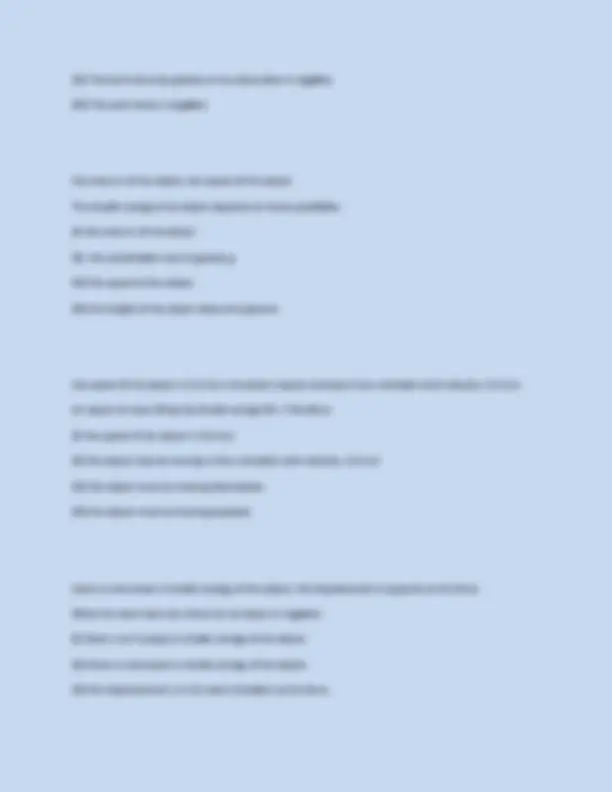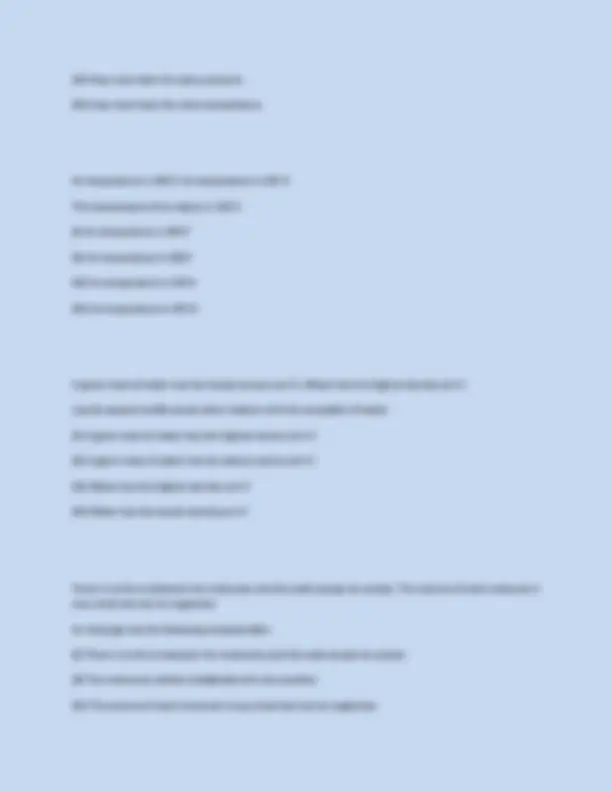















Study with the several resources on Docsity

Earn points by helping other students or get them with a premium plan


Prepare for your exams
Study with the several resources on Docsity

Earn points to download
Earn points by helping other students or get them with a premium plan
Community
Ask the community for help and clear up your study doubts
Discover the best universities in your country according to Docsity users
Free resources
Download our free guides on studying techniques, anxiety management strategies, and thesis advice from Docsity tutors
Physics 2010 Exam Study Guide 65 QUESTIONS Principles Of Physics 1 For Pre-Health Students Exam Questions And Answers 2025-2026.
Typology: Exams
1 / 21

This page cannot be seen from the preview
Don't miss anything!














distance is measure in meters, displacement is measure in meters, distance and displacement of an object from one point to another need not always be equal
(I) Distance is measured in meters
(II) Displacement is measured in meters
(III) Distance and displacement of an object from one point to another are always equal
(IV) Distance and displacement of an object from one point to another need not always be equal.
its displacement time graph is a straight line with a positive slope, its velocity time graph is a straight horizontal line
An object A is traveling in the positive direction with a constant speed of 10 m/s.
(I) Its displacement time graph is a straight horizontal line
(II) Its displacement time graph is a straight line with a positive slope
(III) Its velocity time graph is a straight horizontal line
(IV) Its velocity time graph is a straight line with a positive slope.
it has an average speed of 0.9 m/s, it has an average velocity of - 0.9 m/s
A particle moves from X1 = - 5.0 m to X2 = - 7.7 m in a time interval of 3.0 s.
(I) It has an average speed of 0.9 m/s
(II) It has an average velocity of 0.9 m/s
(III) It has an average velocity of - 0.9 m/s
(IV) It has an average speed of - 0.9 m/s
a horizontal straight line, a straight line above the time axis
A displacement time graph slopes upwards with a constant slope. Therefore the corresponding velocity time graph must be
(I) a straight line sloping upwards
(II) a horizontal straight line
(III) a straight line above the time axis.
a negative acceleration, a decreasing velocity
A velocity time graph has a negative slope. This means the object has
(I) a negative velocity
(II) a negative displacement
(III) a negative acceleration
(IV) a decreasing velocity.
velocity is measured in m/s, acceleration has magnitude and direction
(I) speed is a vector
(II) velocity is measured in m/s
(III) acceleration has magnitude and direction.
the sum of two vectors is always a vector unless they cancel each other, A and B are vectors. If A + B = 0, then B = - A
(I) The sum of two vectors is always a vector unless they cancel each other.
(II) If the magnitude of A is 4 and the magnitude of B is 3 then the magnitude of A + B is 5.
(III) the vector - A has a negative magnitude
(IV) A and B are vectors. If A + B = 0, then B = - A
vertical acceleration of a stone thrown upwards is - 9.8 m/s2, horizontal acceleration of a football (after it leaves the thrower or kicker) is zero
Up is taken positive and right is taken positive. Neglect air resistance.
(I) acceleration due to gravity g = - 9.8 m/s
(II) vertical acceleration of a stone thrown upwards is - 9.8 m/s
(III) vertical acceleration of a stone dropped from a height is +9.8 m/s
(IV) horizontal acceleration of a football (after it leaves the thrower or kicker) is zero.
a stone and a feather will drop with the same acceleration, an ice crystal will accelerate with magnitude 9.8 m/s
Inside a vacuum chamber (no air) on the surface of the earth
(I) a stone and a feather will drop with the same acceleration
(II) the heavier object will drop with the greater acceleration
(III) an ice crystal will accelerate with magnitude 9.8 m/s
(IV) a candy bar will accelerate with magnitude - 9.8 m/s
the speed with which it hits the ground depends on the height, the acceleration of the stone is independent of the height or the weight
A stone is dropped from a height. Neglect air resistance.
(I) the speed with which it hits the ground depends on the height
(II) the acceleration with it hits the ground depends on the height.
(III) the speed with which it hits the ground depends on the weight of the stone.
(IV) the acceleration of the stone is independent of the height or the weight
the total distance traveled is 8.0 km, the net displacement is in the direction NE
A displacement of 4.0 km E is followed by a displacement of 4.0 km N.
(I) the total distance traveled is 8.0 km.
(II) the total distance traveled is 5.7 km.
(III) the net displacement is in the direction NE
(IV) the net displacement is in the direction SW
the stone has an acceleration of - 9.8 m/s2 in the vertical direction, the stone has 0 acceleration in the x direction
A stone is thrown up at an angle of 450 with the horizontal x direction. Take the vertical direction to be y. Neglect air resistance.
(I) the stone has an acceleration of - 9.8 m/s2 in the vertical direction.
(II) the stone has an acceleration of 9.8 cos 450 in the horizontal direction.
(III) the stone has 0 acceleration in the x direction
(IV) the acceleration of the stone changes during its flight.
(II) The work done by the force is negative
(III) The magnitude of the work would be the same as if the force and displacement were in the same direction
(IV) The work done by the force is zero
Force is a vector, because it has direction, Work is a scalar
(I) Displacement is a scalar, because it has no direction.
(II) Work is a vector
(III) Force is a vector, because it has direction.
(IV) Work is a scalar.
positive when the stone moves downwards, negative when the stone moves upwards
A stone is thrown up into the air. The work done by gravity on the stone is
(I) positive when the stone moves upwards
(II) positive when the stone moves downwards
(III) negative when the stone moves upwards
(IV) negative when the stone moves downwards
The work done by the magnetic force on the steel plate is positive, The work done by gravity on the steel plate is negative
A magnet attached to a crane lifts a steel plate upward from the ground.
(I) The work done is positive
(II) The work done by the magnetic force on the steel plate is positive.
(III) The work done by gravity on the steel plate is negative.
(IV) The work done is negative
the mass m of the object, the speed of the object
The kinetic energy of an object depends on these quantities:
(I) the mass m of the object
(II). the acceleration due to gravity g.
(III) the speed of the object
(IV) the height of the object above the ground.
the speed of the object is 2.0 m/s, the object may be moving in the x direction with velocity - 2.0 m/s
An object of mass 20 kg has kinetic energy 40 J. Therefore:
(I) the speed of the object is 2.0 m/s
(II) the object may be moving in the x direction with velocity - 2.0 m/s
(III) the object must be moving downwards
(IV) the object must be moving upwards
there is a decrease in kinetic energy of the object, the displacement is opposite to the force
When the work done by a force on an object is negative
(I) there is an increase in kinetic energy of the object
(II) there is a decrease in kinetic energy of the object.
(III) the displacement is in the same direction as the force.
The mechanical energy of the ball remains the same between bounces, Some mechanical energy is converted into heat and sound at each bounce
A basketball bounces on the floor, losing some mechanical energy with each bounce.
(I) The mechanical energy of the ball always remains the same
(II) The mechanical energy of the ball remains the same between bounces.
(III) The mechanical energy of the ball is the same before and after a bounce.
(IV) Some mechanical energy is converted into heat and sound at each bounce.
Friction is an example of a nonconservative force, The work done by friction is dependent of the path
(I) Friction is an example of a conservative force
(II) Friction is an example of a nonconservative force.
(III) Friction always acts in the same direction as a displacement or attempted displacement.
(IV) The work done by friction is dependent of the path.
kinetic energy of the object must decrease
When kinetic friction acts on an object
(I) The kinetic energy of the object must decrease
(II) The potential energy of the object must decrease
(III) The mechanical energy of the object must increase
(IV) The mechanical energy of the object remains the same
Power is a measure of the rate at which energy is produced, Power is a measure of the rate at which energy is consumed
(I) Power is a measure of the rate at which energy is produced
(II) Power is measured in joules.
(III) Power is a measure of the rate at which energy is consumed
(IV) Power is measured in watts/second (W/s).
it would expand or contract by 0.04 m, its potential energy would increase
The spring constant k of a spring is 500 N/m. If a force of 20 N is applied to the spring
(I) it would expand or contract by 0.04 m.
(II) it would expand or contract by 0.4 m.
(III) its potential energy would decrease.
(IV) its potential energy would increase.
Its potential energy increases by 50 J, The compressing force has an average power of 10 W
A spring has k = 2500 N/m. It is compressed though 20 cm in 5 seconds.
(I) Its potential energy increases by 50 J.
(II) Its potential energy increases by 500000 J
(III) The compressing force has an average power of 10 W.
(IV) The compressing force has an average power of 100000 W.
30000 N, 3.0 x 104 N
A truck has a traction power of 900 kW. What force must it exert in order to pull a load at 30 m/s?
(IV) Its momentum has a vertical component of - 6.0 kg m/s
The momentum of B before and after collision are different, The total momentum of A and B remains the same
Objects A and B having unequal masses collide and move apart after collision.
(I) The momentum of A before and after collision is the same.
(II) The momentum of B before and after collision are different.
(III) The total momentum of A and B remains the same.
(IV) The sum of the velocities of A and B remains the same.
This is an example of an inelastic collision, The total momentum remains constant throughout
Objects A and B collide and become a single object.
(I) This is an example of an elastic collision
(II) This is an example of an inelastic collision
(III) The total momentum remains constant throughout.
(IV) The kinetic energy of the system remains constant throughout.
the total momentum of the system will be 6 kg m/s, the kinetic energy of the system will be 6 J
A ball A of mass 3 kg moving at 2 m/s collides with an identical stationary ball B along the line of centers. After collision
(I) the total momentum of the system will be 6 kg m/s
(II) the ball A will have momentum 3 kg m/s
(III) The ball B will move at 1 m/s
(IV) the kinetic energy of the system will be 6 J
The total momentum is conserved, The total kinetic energy is conserved
Two objects collide elastically.
(I) The total momentum is conserved.
(II) The sum of the velocities is conserved.
(III) The total kinetic energy is conserved.
(IV) The objects stick to each other after collision
the total momentum is - 2 kg m/s, the total kinetic energy before collision is 3 J
Object A mass 2 kg moving at 1 m/s to the right (positive) collides with object B of mass 4 kg moving in the opposite direction with speed 1 m/s.
(I) the total momentum is + 6 kg m/s
(II) the total momentum is - 2 kg m/s
(III) the total kinetic energy before collision is 3 J.
(IV) the total kinetic energy before collision is 1 J
the final total momentum of the fragments is 0, If the speed of the 3kg mass is 2 m/s, then the speed of the 2 kg mass is 3 m/s
A stationary bomb of mass 5 kg explodes into two fragments of masses 3 kg and 2 kg.
(I) the final total momentum of the fragments is 0.
(II) If the speed of the 3kg mass is 2 m/s, then the speed of the 2 kg mass is 2 m/s
(III) the total kinetic energy of the fragments after explosion is 0.
Density is measured in kg/m3, Density is a scalar
(I) Density is measured in kg/m
(II) Density is a vector
(III) Density is a scalar
(IV) Density equals pressure multiplied by volume
A will float if the density of A is less than the density of B, A will experience an upward force of buoyancy
A solid A is dropped into a liquid B.
(I) A will float if the density of A is less than the density of B
(II) A will sink if the density of A is less than the density of B
(III) A will experience an upward force of buoyancy.
(IV) A will experience a downward force of buoyancy.
Specific gravity has no units, The specific gravity of water at 4 C is 1
The specific gravity of a substance is its density divided by the density of water at 4 C.
(I) Specific gravity has no units
(II) Specific gravity has the same unity as density
(III) The specific gravity of water at 4 C is zero
(IV) The specific gravity of water at 4 C is 1
Liquid in a pipe flows faster when the cross sectional area is smaller, The speed of a liquid in a pipe is inversely proportional to the cross sectional area
The equation of continuity says A1V1 = A2V2. This implies
(I) Liquid in a pipe flows faster when the cross sectional area is smaller
(II) Liquid in a pipe flows faster when the cross sectional area is greater
(III) The speed of a liquid in a pipe is directly proportional to the cross sectional area
(IV) The speed of a liquid in a pipe is inversely proportional to the cross sectional area.
The density of A is less than the density of B, The specific gravity of A is less than the specific gravity of B
A solid A floats in a liquid B with half of its volume above the liquid surface.
(I) The density of A is greater than the density of B.
(II) The density of A is less than the density of B.
(III) The specific gravity of A is greater than the specific gravity of B.
(IV) The specific gravity of A is less than the specific gravity of B.
Pascal's Law or Principle
When a rubber tire is filled with air by a pump the pressure from the pump is transmitted equally throughout the air inside the tire. This illustrates
(I) Pascal's Law or Principle
(II) Bernoulli's Principle
(III) Archimedes' Principle
(IV) None of the above
Buoyancy is measured in newtons (N), Buoyancy is a force
(I) Buoyancy is a pressure
(II) Buoyancy is measured in newtons (N)
(III) they must have the same pressure
(IV) they must have the same temperature
Its temperature is 248 F, Its temperature is 393 K
The temperature of an object is 120 C.
(I) Its temperature is 248 F
(II) Its temperature is 200 F
(III) Its temperature is 393 K
(IV) Its temperature is 293 K
A given mass of water has the lowest volume at 4 C, Water has the highest density at 4 C
Liquids expand continuously when heated, with the exception of water.
(I) A given mass of water has the highest volume at 4 C
(II) A given mass of water has the lowest volume at 4 C
(III) Water has the highest density at 4 C
(IV) Water has the lowest density at 4 C
There is no force between the molecules and the walls except at contact, The volume of each molecule is very small and can be neglected
An ideal gas has the following characteristics
(I) There is no force between the molecules and the walls except at contact
(II) The molecules collide inelastically with one another.
(III) The volume of each molecule is very small and can be neglected.
(IV) All the molecules have exactly the same kinetic energy at all times.
The pressure increases with temperature when the volume is kept constant, The volume increases with temperature when the pressure is kept constant
An ideal gas follows these laws:
(I) The pressure increases with temperature when the volume is kept constant.
(II) The pressure never changes with temperature.
(III) The volume increases with temperature when the pressure is kept constant.
(IV) The volume never changes with temperature.
is proportional to temperature T, is proportional to the number of molecules N
The product of the pressured and volume (PV) of an ideal has
(I) is independent of temperature T.
(II) is proportional to temperature T.
(III) is independent of the number of molecules N.
(IV) is proportional to the number of molecules N.
the force applied by many molecules colliding with the walls of the container, the molecules imparting an impulse to the walls by collision
The pressure of a gas is caused by
(I) the force applied by many molecules colliding with the walls of the container
(II) the mass of the molecules
(III) the molecules imparting an impulse to the walls by collision